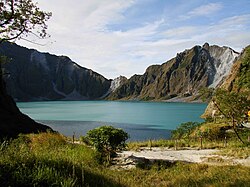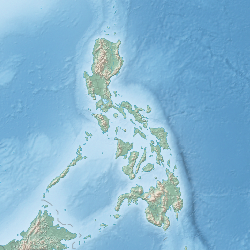Lake Pinatubo
| Lake Pinatubo | |
|---|---|

The crater lake, formed after the 1991 eruption of Mount Pinatubo
|
|
| Location | Mount Pinatubo, Luzon |
| Coordinates | 15°8′37″N 120°21′1″E / 15.14361°N 120.35028°ECoordinates: 15°8′37″N 120°21′1″E / 15.14361°N 120.35028°E |
| Type | crater lake |
| Primary inflows | Precipitation only |
| Primary outflows | Bucao River; other smaller rivers and creeks |
| Catchment area | 5 km2 (2 sq mi) |
| Basin countries | Philippines |
| Max. width | 2.5 km (1.6 mi) |
| Surface area | 183 ha (450 acres) |
| Max. depth | 600 m (2,000 ft) |
| Surface elevation | 900 m (3,000 ft) |
| Settlements | |
Lake Pinatubo (Filipino: Lawa ng Pinatubo) is the summit crater lake of Mount Pinatubo formed after its climactic eruption on June 15, 1991. The lake is located near the boundaries of Pampanga, Tarlac and Zambales provinces in the Philippines and is the deepest lake in the country at 600 m (2,000 ft). It is about 90 km (56 mi) northwest of the capital city of Manila.
Mount Pinatubo's volcanic activity has followed a cycle: centuries of repose terminated by a caldera-forming eruption with large pyroclastic flows; a post-eruption aftermath of rain-triggered lahars in surrounding drainages and dome-building that fills the caldera; and then another long quiescent period. During and after the eruptions, lahars descending along volcano channels may block tributaries from watersheds beyond Pinatubo, creating natural lakes. Geophysical evidence shows that there were at least two ancient lakes in the Mapanuepe River valley in the southwestern part of the volcano.
The climactic 1991 eruption of Mount Pinatubo destroyed the volcano's original summit. In its place is a 2.5 kilometres (1.6 mi) diameter caldera, the center of which is offset 1 kilometre (0.62 mi) northward from the pre-eruption summit. It was created from the collapse of the volcano's summit on June 15, during the period of abundant large earthquakes in response to withdrawal of a large volume of magma from the reservoir beneath the volcano. By early September 1991, a shallow lake formed. The high precipitation rate of the area led to a rapid transition from a small and hot acid lake to a large lake with near-ambient temperature and pH.
The mountain range wherein the volcano is located is inhabited by the indigenous Aetas. An old Aeta legend tells of a lake that once existed in the site, most probably the latter of the two ancient crater lakes, and of a great explosion that destroyed it.
...
Wikipedia

